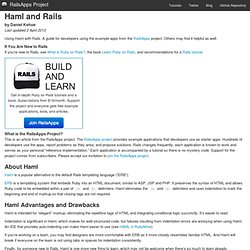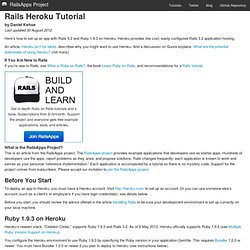

Rails Default Application Layout for HTML5. By Daniel Kehoe Last updated 3 August 2014 Rails application layout for HTML5.

Shows how to set up an application layout with navigation links, messages for alerts and notices, and CSS styling for Rails. If You Are New to Rails If you’re new to Rails, see What is Ruby on Rails? What is the RailsApps Project? This is an article from the RailsApps project. Background The default application layout is where you put HTML that you want to include on every page of your website. Every Rails application needs a well-designed application layout. Rails will use the layout defined in the file app/views/layouts/application.html.erb as a default for rendering any page. HTML5 Boilerplate The well-known HTML5 Boilerplate project has been recommending “best practice” tweaks to web pages since 2010.
Front-end Frameworks This article shows how to set up a simple application layout with navigation links, messages for alerts and notices, and CSS styling for Rails. Example Gemfiles for Rails 3.2. By Daniel Kehoe Last updated 21 February 2013 Here are example Gemfiles for typical applications built with Rails 3.2.

See Installing Rails 3.2 for detailed instructions and advice. John Mcdowall offers some useful advice about Gemfile Best Practices. Haml and Rails. By Daniel Kehoe Last updated 2 April 2013.

Haml. Managing Rails Versions and Gems. By Daniel Kehoe Last updated 17 November 2014 Learn tips and tricks for managing Rails and Ruby gems.

Relieve your headaches when versions collide. This is a guide for developers using the example apps from the Rails Apps repository. Others may find it helpful as well. Before you install one of the Rails example apps, there are a few things you should know about managing the pieces of the Rails platform. Twitter Bootstrap and Rails. Guide to HTML5 Boilerplate for Rails Developers. By Daniel Kehoe Last updated 20 November 2011 This is a guide to HTML5 Boilerplate for Rails developers.

Like Rails on the server side or “backend”, HTML5 Boilerplate provides structure and conventions for setting up HTML5, CSS3 styles, and Javascript for front-end development. It is a popular starting point for many front-end developers. However, some aspects of HTML5 Boilerplate are not useful for Rails projects. If You Are New to Rails If you’re new to Rails, see What is Ruby on Rails? What is the RailsApps Project? This is an article from the RailsApps project.
About HTML5 Boilerplate HTML5 Boilerplate has been available since August 10th, 2010. On a first encounter, it seems HTML5 Boilerplate includes “everything but the kitchen sink.” This article provides commentary plus links to the relevant HTML5 Boilerplate documentation for each component. Using Git with Rails.
By Daniel Kehoe Last updated 4 September 2013 Using Git and GitHub with Rails.

Git provides a source control repository. Use Git to roll back code changes as needed, when you are collaborating with others, and when you must deploy an app for hosting with a service such as Heroku. Get a GitHub account for remote backup and collaboration. If you are building a throw-away app for your own education, you may decide not to use Git, but sooner or later you will need to learn to use Git to participate in the open source community.
If You Are New to Rails If you’re new to Rails, see What is Ruby on Rails? What is the RailsApps Project? This is an article from the RailsApps project. Git Explained You’ll use Git to record the changes you make to your project over time. Commits contain a change a user has made to the code and some additional useful metadata. Learning Git If you are new to Git, you can read a free online version of the book Pro Git by Scott Chacon. Got Git? $ git version Install Git Hi ...! Rails on Heroku. By Daniel Kehoe Last updated 30 August 2012 Here’s how to set up an app with Rails 3.2 and Ruby 1.9.3 on Heroku.

Heroku provides low cost, easily configured Rails 3.2 application hosting. An article, Heroku Isn’t for Idiots, describes why you might want to use Heroku. And a discussion on Quora explains, What are the potential downsides of using Heroku?